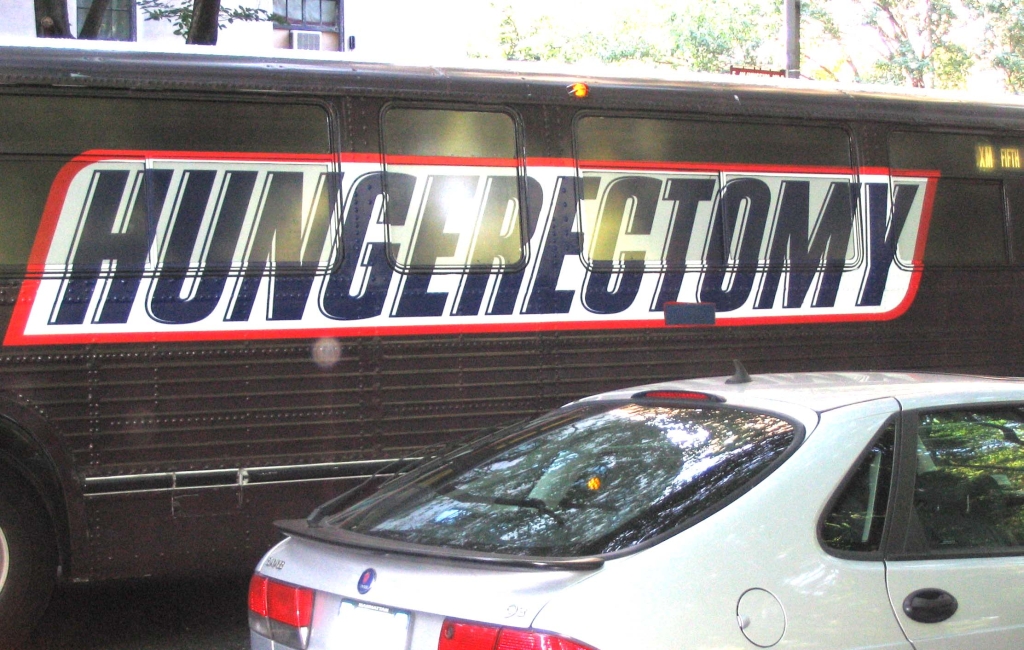Two strong points I do not possess: a good understanding of economics and the ability to understand or judge works of art. From this one might conclude that spending money on art not mass produced for sale at CB2 or a university poster sale may not be wise.
Friday night I attended an opening for a local artist named
Quang Hong. I first saw Quang's work when it was on display at Menagerie, the former Belmont Avenue restaurant. At the time, my sophisticated reaction to his work was Spicoli-esque. If I had to describe his work (and I guess it would be helpful), I would use words like surreal, isolated, monstrous, Asian-inspired, darkly funny. That doesn't help. Look at his website.
After walking around, drinking an Old Style, and eating some beef kalbi with my fingers, I teamed up to negotiate a price for two of his paintings. I want art for my apartment, but this was more than a modest-sized impulse purchase.
One painting is called "Tick-O" and is, shockingly, a painting of a tick, or of a vaguely cartoonish tick-like creature. It does not look like
The Tick though. The other is called "Venus Pancake" and is of a gaunt woman wearing a long red dress and standing alone in a desolate landscape. I really like this painting, but I fear that it may be too reminiscent of moody teen girl cartoon icon
Emily Strange. I may be imagining this resemblance, but I'm pretty sure that by the time I pick the paintings up from the gallery I will have firmly convinced myself that everyone who sees this painting in my apartment (or worse, in my bedroom where I originally thought I'd put it) will suspect that I spend my nights trying to pick up fourteen year olds on
Alkaline Trio message boards.
How to know if I didn't get totally ripped off? There's no real resource to compare purchase price histories as you can with artists whose work is up for auction. Maybe the monetary value of a local artist's work has nothing to do with value in the art world at large because no one sees it as a real investment. Maybe the value of Quang's work is purely aesthetic whereas a Picasso derives its value from the anticipation of accrual. In any event, I hope the value of these paintings is not based solely on my ability to use the paintings as collateral to post bond subsequent to my arrest in an Alkaline Trio message board sting.
* * * * *
In a completely different effort of art appreciation, on Saturday I went with some friends to the midnight showing of the 1980 Olivia Newtown John disasterpiece
Xanadu. In the interest of fair and balanced discussion, you may peruse the evening's organizer's
ode to Xanadu. If you are not interested in this, well, you'll have to blindly adopt my view that this is one horrible flick. Actually, she thinks it's horrible too, but she has an attachment to it born of youthful memory. I do not. My perception of its almost impossible amount of suck is untainted.
Anyway, for those of you who haven't seen this gem I'll give a quick synopsis. Olivia Newton John is a Muse named Kira who befriends and falls for an artist named Sonny Malone. Artist is really a generous term because all Sonny really does is paint copies of album covers for record store displays. Kira is really crappy at musing. She doesn't really inspire him to be a better artist, since Sonny never does have one original artistic creation at any time in the movie. What she does do is help Gene Kelly taint his reputation by encouraging his character, Danny McGuire, to open a rollerskating dance club to recapture the vitality of his youth. Malone and McGuire somehow become partners in this venture even though Malone seems to have a dearth of ideas, experience, credentials, and, most significantly to the business savvy amongst you, capital. At some point, Malone skates through a wall mural to meet Kira's dad, Zeus (yes,
that Zeus), who apparently has left his digs on Mount Olympus and has moved into a condo on the set of
Tron. And that's pretty much about it.
To keep with the larger theme, what is the value of
Xanadu? Well, the movie itself wasn't actually worth the $9.25 charged by the Music Box. Fortunately for me, the vocally disdainful crowd, never shy about letting the characters know how cheesy, poorly dressed, and insipid they were, was totally worth it. In fact, I would estimate that such aggressively ironic enjoyment would be worth at least $13 on the open market. So, the moral of the story is that I am way more confident about estimating the value of the overzealous use of the special effects mixed with abysmal dialogue than I am of creations that I really feel are striking or beautiful.



















